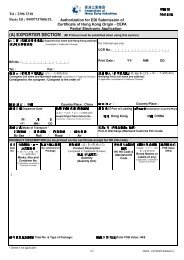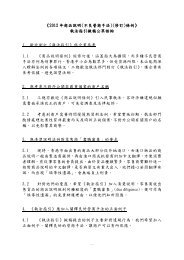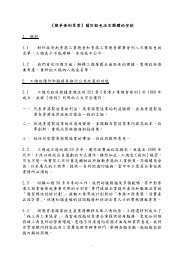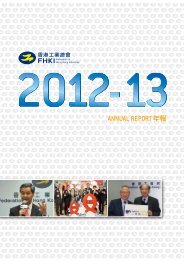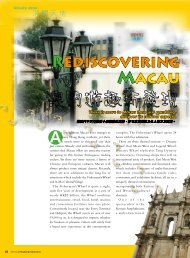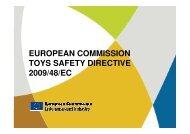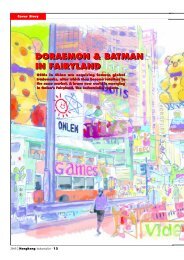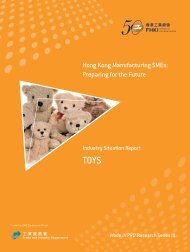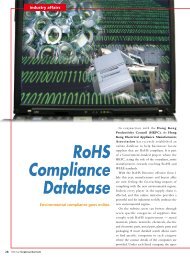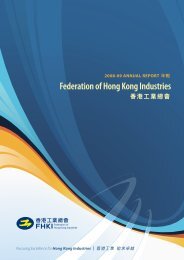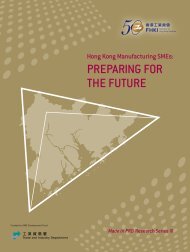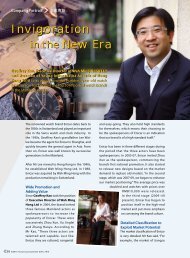Toys Safety Directive 2009/48/EC chemical requirements
Toys Safety Directive 2009/48/EC chemical requirements
Toys Safety Directive 2009/48/EC chemical requirements
- No tags were found...
Create successful ePaper yourself
Turn your PDF publications into a flip-book with our unique Google optimized e-Paper software.
<strong>Toys</strong> <strong>Safety</strong> <strong>Directive</strong> <strong>2009</strong>/<strong>48</strong>/<strong>EC</strong><strong>chemical</strong> <strong>requirements</strong>Maureen Logghe
<strong>2009</strong>/<strong>48</strong>/<strong>EC</strong> , ANNEX II, Item IIIChemical propertiesPoint 1: The general <strong>chemical</strong> safetyrequirement<strong>Toys</strong> shall be designed and manufactured in such a way that:‣ They present no risk of adverse health effects due to exposure to<strong>chemical</strong> substances/mixtures in toys during foreseeable use‣ They comply with the relevant Community legislation relating tocertain products or restrictions for certain substances/mixturesUntil 20 July 2013, the <strong>chemical</strong> <strong>requirements</strong> in 88/378/E<strong>EC</strong> apply.The general <strong>chemical</strong> safety requirement is practically the same inthe two directives but the particular safety <strong>requirements</strong> change.
Toy safety directive,<strong>2009</strong>/<strong>48</strong>/<strong>EC</strong>HeaderCosmetic directive,76/768/E<strong>EC</strong>CLP,<strong>EC</strong>/1272/2008REACH,<strong>EC</strong>/1907/2006RoHS directive,2002/95/<strong>EC</strong>National restrictionsFood contact materials,2002/72/<strong>EC</strong>
Specific <strong>chemical</strong> safety <strong>requirements</strong>Point 2: <strong>Toys</strong> that are substances andmixtures<strong>Toys</strong> that are themselves substances or mixtures must comply with‣ <strong>Directive</strong> 67/5<strong>48</strong>/E<strong>EC</strong> (dangerous substances <strong>Directive</strong>, DSD), and‣ <strong>Directive</strong> 1999/45/E<strong>EC</strong> (dangerous preparations <strong>Directive</strong>, DPD), and‣ Regulation 1272/2008 (CLP – Classification, labelling and packagingof substances and mixtures)‣ The CLP –regulation will replace the two directives by 1 June 2015after a period of transitional provisions
• <strong>Toys</strong> that are substances or mixtures mustcomply with CLP. Hence, the toy (thesubstance or the mixture) must belabelled accordingly if it fulfils the criteriafor classification• Eg. finger paint, crayon, slime and playdough• If such products contain dangeroussubstances they might need to be labelled
Point 3: Prohibition of CMRsSubstances classified as CMR (Carcinogenic, Mutagenic or toxic forReproduction) of category 1A, 1B or 2 as specified in CLP (Regulation(<strong>EC</strong>) No 1272/2008) shall not be used in toys, in components of toys or inmicro-structurally distinct parts of toys.“Structurally distinct part”:‣ • “homogenous material”‣ Can be visually distincted from its surroundings: a bicycle has several“parts” (saddle, fork etc) but each of them can have severalhomogenous materials“Micro-structurally “:‣ e.g. a thin coating on a base materialNote: CLP defines categories 1 A, 1 B and 2.Classification in DPD refers to category 1, 2 and 3
Point 4: Exemptions to the CMR-prohibition for Category 1Aand 1BSubstances and mixtures classified as CMR category 1 A and 1 B(according to CLP) are exempted from the prohibition in point 3 if:‣ The individual concentration is below the limits specified in CLP‣ The substance/mixture is inaccessible in any form incl. inhalation‣ The substance/mixture is listed in Appendix A to Annex II.Such listing requires that three criteria are fulfilled:‣ Scientific Committee found it safe and reviews this every 5 years‣ There are no suitable alternatives (documented analysis needed)‣ Not prohibited by REACH for use in consumer articlesNote: In comparison to the limits in CLP, until1 June 2015 other concentration limits mayapply in DPDC M RCat 1A 0,1% 0,1% 0,3%Cat 1B 0,1% 0,1% 0,3%Cat 2 1% 1% 3%
Point 5: Exemptions to the CMR-prohibition for Category 2Same conditions as for CMRs category 1 A and B with one difference:The Commission decision to list it in Appendix A to Annex II can be takenbased on the following two criteria:‣ Scientific Committee has found it to be safe‣ Not prohibited by REACH for use in consumer articlesNote: The criterion that there no suitable alternatives are availabledoes not apply for listing of a CMR category 2 (applies for category 1 Aand 1 B)Note: An application will be made to list in Appendix A (before 20 July2013) “Nickel in electrically conductive surfaces”
Point 6: Exemption for Nickel in stainless steel from points 3, 4and 5“Points 3, 4 and 5 shall not apply to nickel in stainless steel”Note: The derogation for nickel in stainless steel does not applyto nickel in coatings.
Point 7: Exemptions to the CMR-prohibition for approved Foodcontact materials and materials complying with limits inAppendix CStricter concentration limits can be listed in Appendix C of Annex II:‣ Requires a Commission Decision‣ Applies to <strong>chemical</strong>s in toys intended for children under 36 monthsand toys intended to be placed in the mouth‣ Stricter limit values can be justified due to the higher exposure forthese categories of toysMaterials covered by and complying with Food Contact Materiallegislation are allowed in toys until 20 July 2017
Point 8: Prohibition of nitrosamines in certain toysScope:N-nitrosamines and N-nitrosatable substances in toys for children under36 months or in other toys intended to be put in the mouth.Migration limits are :‣ 0,05 mg/kg for N-nitrosamines‣ 1 mg/kg for N-nitrosatable substances“Intended to be placed in the mouth" refers to teethers, balloons etc butnot to e.g. bicycle tyres. Particular relevance for rubber material andfinger paints
Point 9: Requires the Commission to systematically and regularlyevaluate the occurrence of hazardous substances of materials in toys.Point 10: cosmetic toys shall comply with the compositional andlabeling <strong>requirements</strong> of the cosmetics directive 76/768/E<strong>EC</strong>• Cosmetic toys shall comply with both TSD andthe cosmetic directive (76/768/E<strong>EC</strong>). E.g. makeup for a doll. Attention on:Appendix with allowed preservatives and colours.Cosmetic shall for example have a list of ingredients and a “best before” date
Point 11: Prohibition for fragrances and marking <strong>requirements</strong>‣ <strong>Toys</strong> shall not contain any of 55 listed allergenic fragrances‣ Traces are allowed if technically unavoidable under goodmanufacturing practice and does not exceed 100 mg/kg‣ 11 other allergenic fragrances shall be labeled if added to a toy atconcentrations exceeding 100 mg/kgGuidelines for interpretation of the cosmetics directive:http://ec.europa.eu/consumers/sectors/cosmetics/documents/guidelines/
Point 12: Derogations from the fragranceprohibitionAn exemption to the prohibition of the 15 “extra” fragrances (41 – 55)applies to:‣ Olfactory board games (learn to recognize different odours/flavours)‣ Gustative games (allow children to make sweets or dishes)‣ Cosmetic kits (a toy the purpose of which is to assist a child to learnto make products such as fragrances, soap, make-up, etc)Provided that:‣ The fragrances are labeled on the packaging and a warning is present“contains fragrances that may cause allergies”‣ the resulting products, made in accordance with the instructions,comply with the <strong>requirements</strong> of Cosmetics directive, if applicable,and the fragrances comply with the relevant legislation on food, ifapplicable‣ The toy carries a warning “Not suitable for children under 3 years”with indication of the hazard
Point 13: Migration limits‣ Migration limits apply to 19 elements :Aluminium, Antimony, Arsenic, Barium, Boron, Cadmium, Chromium,Chromium (VI), Cobalt, Copper, Lead, Manganese, Mercury, Nickel,Selenium, Strontium, Tin, Organic tin, Zinc‣ The <strong>requirements</strong> apply in addition to the CMR-prohibition‣ Apply to accessible toys/components (after foreseeable use test)‣ Limits for arsenic, cadmium, chromium VI, lead, mercury and organictins are set at 50 % of what is considered safe by scientific committee‣ Different limits for different material types‣ Dry, brittle, powder-like or pliable toy materials‣ Liquid and sticky toy materials‣ Scraped-off toy materials.
Requirements in the TSD• The <strong>chemical</strong> <strong>requirements</strong> enters intoforce 20 July 2013• Migration limits can be changed viacommittee procedures, when new scientificdata are available• Specific limits for substances in toysintended for children under 36 months ortoys intended to be put in the mouth canbe amended via committee procedureNew limits for different substances can beexpected!
Migration limits• Cadmium• http://eurlex.europa.eu/LexUriServ/LexUriServ.do?uri=OJ:L:2012:064:0007:0008:EN:PDF
Migration limits• Lead• http://ec.europa.eu/enterprise/sectors/toys/public-consultation-lead/index_en.htm
Migration limits• Barium• Opinion SCHER:http://ec.europa.eu/health/scientific_committees/environmental_risks/docs/scher_o_161.pdf• Aim: new limits a factor of 3 lower
CMR substances• TCEP, TCPP, TDCP• Opinion SCHER:http://ec.europa.eu/health/scientific_committees/environmental_risks/docs/scher_o_158.pdf• Aim: amend appendic C with a limit value of 5mg/kg (tbd)
Expert WG <strong>chemical</strong>s and Committee• Under consideration to set specific limit values for<strong>chemical</strong>s used in toys intended for use bychildren < 36 months or in toys intended to beplaced in the mouth:•• Kathone• Formamide
Expert WG <strong>chemical</strong>s and Committee• Under consideration to list CMR substances andtheir permitted uses:•• metallic nickel in materials where its use isnecessary for the correct electrical function oftoys (i.e. plating, coating and alloys enablingelectrical conductivity)
Restriction of phthalates, annex XVIIRequirement in REACH (1)• DEHP, DBP and BBP are restricted in alltoys and childcare articles atconcentrations higher than 0.1 %.• DINP, DIDP and DNOP are restricted intoys and childcare articles atconcentrations higher than 0.1 % in toysand childcare articles which can be placedin the mouth.Guidance documents on articles which can be put in the mouth:http://ec.europa.eu/enterprise/sectors/toys/files/gd008_en.pdf
Restriction of cadmium, benzene and mercury, annex XVIIRequirement in REACH (2)• Cadmium is restricted asstabiliser in polymers and shallnot be used to give colour tofinished articles in concentrationsabove 100 ppm• Benzene is restricted in toys inconcentration above 5 ppm• From 2017, 5 specificphenylmercury compounds arerestricted in articles, substancesand mixtures in concentrationsabove 100 ppm
Restriction of organic tin compounds, annex XVIIRequirement in REACH (3)• Tri-substituted organic tin compounds like TBTand TPT shall not be used in articles inconcentration above 0.1 % by weight of tin• DBT shall not be used in articles inconcentration above 0.1 % by weight of tinFor some uses the ban will apply from January 2015• DOT shall not be used in concentrations above0.1 % in:Textiles intended to come into contract with the skinChildcare articlesNappiesOther articles that are not relevant for toys
Restriction of azocolourants, annex XVIIRequirement in REACH (4)• Azodyes which may release one ormore of 22 specific aromatic aminesin concentrations above 30 ppm,shall not be used in textile or leatherarticles which may come inprolonged contact with human skinor oral cavity.• A test method is given in appendix10 of REACH• Restriction is made to limit theexposure to carcinogenic substances• <strong>Toys</strong> which have higherconcentrations of one or more of thearomatic amines will pose a seriousrisk to the children.
Restriction on the use of certain hazardous substances in electrical andelectronic equipmentRoHS directive• Electrical and electronic equipment shall notcontain:Lead (1000 ppm)Mercury (100 ppm)Cadmium (100 ppm)Chromium VI (1000 ppm)Polybrominated biphenyls (PBB) (1000 ppm)Polybrominated dephenyl ethers (PBDE) (1000 ppm)
Food contact material• <strong>Toys</strong> that are foodcontact material shallcomply with both thelegislation for foodcontact material and theTSD• Compliance with thelegislation for foodcontact material doesnot necessarely ensuresafe toys• Limit for <strong>chemical</strong>s infood contact materialsare not based on thearticles are used as toys
National restrictions• Phthalates, mercury, lead, phenol,formaldehyde, formamide…..
Chemicalsafetyassessment
<strong>Safety</strong> assessment in <strong>2009</strong>/<strong>48</strong>/<strong>EC</strong>The requirementThe requirement is found in <strong>2009</strong>/<strong>48</strong>/<strong>EC</strong>, article 18:Manufacturers shall, before placing a toy on the market, carry out ananalysis of the <strong>chemical</strong>, physical & mechanical, electrical,flammability, hygiene and radioactivity hazards that the toy maypresent, as well as an assessment of the potential exposure to suchhazards.The aim of a safety assessment is to identify and minimize risks. Canbe done at any point before the toy is placed on the marketThe requirement is in place since 20 July, 2011 also for <strong>chemical</strong>hazards although new <strong>chemical</strong> <strong>requirements</strong> do not come into forceuntil 20 July, 2013. Chemical <strong>requirements</strong> in 88/378/E<strong>EC</strong> applyuntil then (including the general <strong>chemical</strong> requirement).
<strong>Safety</strong> assessment in <strong>2009</strong>/<strong>48</strong>/<strong>EC</strong>The three partsThe safety assessment can be divided in three parts:• Mechanical & physical, flammability and electrical hazards forwhich harmonized standards exist• Hygiene and radioactivity hazards for which currently there are noharmonized standards available and the safety assessment is usedinstead• Chemical hazards for which some standards exist and where themandatory safety assessment is considered to be an alternative to<strong>EC</strong> Type examination for <strong>chemical</strong> hazards that are not covered byharmonized standards• The European Commission has published a guidance document:http://ec.europa.eu/enterprise/sectors/toys/documents/guidance/index_en.htm
<strong>Safety</strong> assessment in <strong>2009</strong>/<strong>48</strong>/<strong>EC</strong>Information and skills needed• Knowledge about the toy (how is it used, by whom, which materialsare used, which substances are used)• Knowledge of applicable standards (including the assessmentsrequired by the standards)• Knowledge of applicable restrictions imposed on certain substancesand the scope of these restrictions• Knowledge about emerging issues• Knowledge about hazards and ability to identify hazards andevaluate risks• Ability to evaluate riskNote: It is permitted to use third party services for the safety assessmentbut the manufacturer is always responsible for its content
Available standards(some new and some revised will be published during 2013)• EN 71-3 “Migration of certain elements”• EN 71-4 “Chemical experimental sets”• EN 71-5 “Chemical toys other than <strong>chemical</strong> sets”• EN 71-7 “Fingerpaints”• EN 71-12 “N-Nitrosamines and Nitrosatable substances”• EN 71-13 “Olfactory board games, cosmetic kits and gustative games”• EN 71-9 “Organic <strong>chemical</strong> compounds” (not referenced in the OJEU –does not give presumption of conformity)No standards expected for CMR-substances or fragrancesNote: The assessment can reduce and/or target testing. Testing only needsto be considered for substances that can reasonably be expected to appearin the toy in question.
Relevant linksGuidance documents from the Commission:http://ec.europa.eu/enterprise/sectors/toys/documents/guidance/index_en.htmThe two most important are:TSD explanatory guidance document andTechnical documentation guidance document



